食品科学与工程专业英语 总结
- 格式:docx
- 大小:22.54 KB
- 文档页数:3

食品专业英语复习资料(祝你好运)1.姓名:名在前、姓在后;作者地址:由小到大的顺序书写,科室,所在单位,所在地(城市、省、国名),邮编等。
E.g. Department of Food Quality and Safety, School of Food Science and Technology, Guangdong Ocean University, Zhanjiang, China, 5240882.述语、组织、团体名称:LC =lethal concentration 致死浓度 EAA =Essential amino acids 必需氨基酸DH = degree of hydrolysis 水解度 DNA =deozyrebonucleic acid 脱氧核糖核酸USDA=US Department of Agriculture 美国农业部 IFT=Institute of Food Technologists 食品科技协会CEO=chief executive officer 总经理3.数字+度量衡单位词15ft (foot\feet) 50rpm (revolutions per minute) cal (calorie) 卡C(centigrade)摄氏温度 etc=et cetera=and others(等物)et al.=et alii=and others(等人) i.e.=id est=that is e.g.=exampli gratia=for example4.公式:+plus 加号;正号-minus 减号;负号±plus or minus 正负号×is multiplied by 乘号÷is divided by 除号=is equal to 等于号%per cent 百分之…℃degree Celsius /centigrade摄氏度273 ℃273 Celsius or 273 degree Celsius5.The inhibition ratio(%)was calculated using the following formula:Inhibition ratio(%)= (A-A1)/A×100%Where A was the absorbance of the control, and A1 was the absorbance of the test sample.由下面的公式计算其抑制率(%):抑制率(%)=(A-A1)/A×100% 式中:A是对照的吸收度,A1是试样的吸收度。
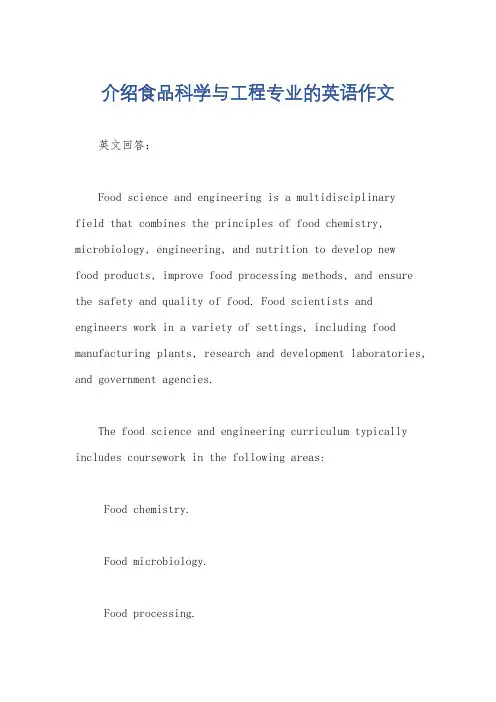
介绍食品科学与工程专业的英语作文英文回答:Food science and engineering is a multidisciplinaryfield that combines the principles of food chemistry, microbiology, engineering, and nutrition to develop newfood products, improve food processing methods, and ensure the safety and quality of food. Food scientists and engineers work in a variety of settings, including food manufacturing plants, research and development laboratories, and government agencies.The food science and engineering curriculum typically includes coursework in the following areas:Food chemistry.Food microbiology.Food processing.Food engineering.Food analysis.Food safety and quality.Students in food science and engineering programs also gain hands-on experience through laboratory work and internships.中文回答:食品科学与工程学是一门多学科交叉领域,它结合食品化学、微生物学、工程学和营养学的原理,以开发新食品、改进食品加工方法并确保食品安全和质量。
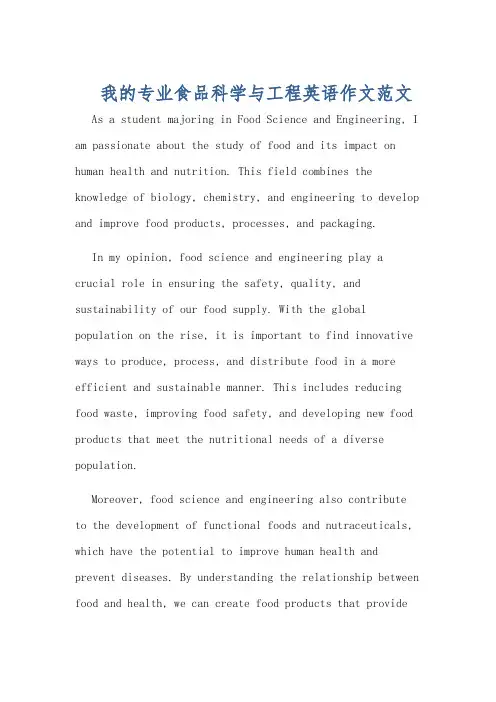
我的专业食品科学与工程英语作文范文As a student majoring in Food Science and Engineering, I am passionate about the study of food and its impact on human health and nutrition. This field combines the knowledge of biology, chemistry, and engineering to develop and improve food products, processes, and packaging.In my opinion, food science and engineering play a crucial role in ensuring the safety, quality, and sustainability of our food supply. With the global population on the rise, it is important to find innovative ways to produce, process, and distribute food in a more efficient and sustainable manner. This includes reducing food waste, improving food safety, and developing new food products that meet the nutritional needs of a diverse population.Moreover, food science and engineering also contributeto the development of functional foods and nutraceuticals, which have the potential to improve human health and prevent diseases. By understanding the relationship between food and health, we can create food products that providespecific health benefits, such as improved digestion, immune support, and heart health.In addition, food science and engineering are essential in addressing the challenges of food security and food safety. With the increasing concerns about foodborne illnesses and food contamination, it is important to develop new technologies and processes to ensure the safety and quality of our food supply. This includes the use of advanced packaging materials, innovative processing techniques, and rapid testing methods to detect and prevent foodborne pathogens.Overall, my studies in food science and engineering have provided me with a deep understanding of the science behind food and its impact on our lives. I am excited to continue learning and researching in this field, and I am confident that my knowledge and skills will contribute to the advancement of food science and engineering in the future.作为一名食品科学与工程专业的学生,我对食品及其对人类健康和营养的影响充满热情。
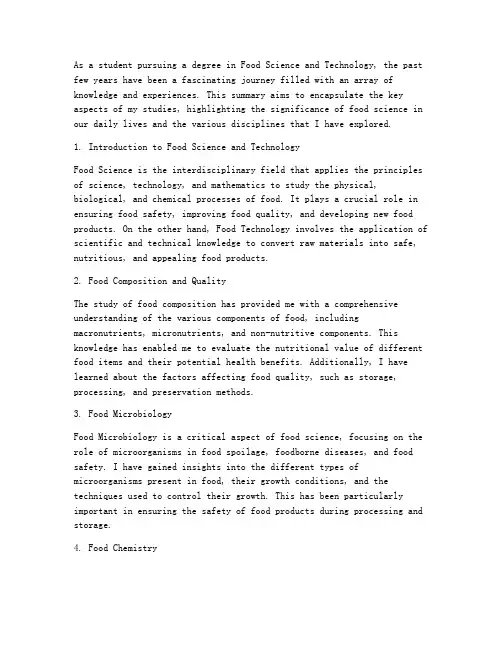
As a student pursuing a degree in Food Science and Technology, the past few years have been a fascinating journey filled with an array of knowledge and experiences. This summary aims to encapsulate the key aspects of my studies, highlighting the significance of food science in our daily lives and the various disciplines that I have explored.1. Introduction to Food Science and TechnologyFood Science is the interdisciplinary field that applies the principles of science, technology, and mathematics to study the physical, biological, and chemical processes of food. It plays a crucial role in ensuring food safety, improving food quality, and developing new food products. On the other hand, Food Technology involves the application of scientific and technical knowledge to convert raw materials into safe, nutritious, and appealing food products.2. Food Composition and QualityThe study of food composition has provided me with a comprehensive understanding of the various components of food, including macronutrients, micronutrients, and non-nutritive components. This knowledge has enabled me to evaluate the nutritional value of different food items and their potential health benefits. Additionally, I have learned about the factors affecting food quality, such as storage, processing, and preservation methods.3. Food MicrobiologyFood Microbiology is a critical aspect of food science, focusing on the role of microorganisms in food spoilage, foodborne diseases, and food safety. I have gained insights into the different types of microorganisms present in food, their growth conditions, and the techniques used to control their growth. This has been particularly important in ensuring the safety of food products during processing and storage.4. Food ChemistryFood Chemistry involves the study of the chemical reactions and transformations that occur in food during processing, storage, and consumption. My studies in this area have provided me with a deeper understanding of the physical, chemical, and biochemical properties of food components, such as proteins, carbohydrates, fats, and vitamins. This knowledge has been instrumental in developing new food products and improving existing ones.5. Food Processing and PreservationFood processing techniques have been a major focus of my studies, covering topics such as thermal processing, refrigeration, and packaging.I have learned about the different methods used to preserve food, suchas canning, freezing, and drying, and their impact on food quality and safety. This has been particularly relevant in extending the shelf-life of food products and ensuring their availability throughout the year.6. Food Safety and Quality ControlFood safety is of paramount importance in the food industry, and I have gained a thorough understanding of the principles and practices involved in ensuring food safety. This includes the identification and control of potential hazards, such as pathogens, allergens, and contaminants. I have also learned about quality control systems, such as HACCP (Hazard Analysis and Critical Control Points), which are essential inmaintaining high standards of food quality.7. Food Regulations and StandardsFood regulations and standards are essential in protecting consumer health and ensuring fair trade practices in the food industry. Mystudies have equipped me with the knowledge of various food regulations, such as those related to labeling, additives, and import/export requirements. This has been particularly useful in understanding thelegal aspects of food production and distribution.In conclusion, my studies in Food Science and Technology have provided me with a comprehensive understanding of the food industry, from the raw materials to the final product. The knowledge and skills acquired duringthis journey have not only prepared me for a career in the food industry but have also enhanced my appreciation for the importance of food in our daily lives. As I move forward, I am excited to apply my knowledge and passion to contribute to the development of safe, nutritious, and sustainable food systems.。
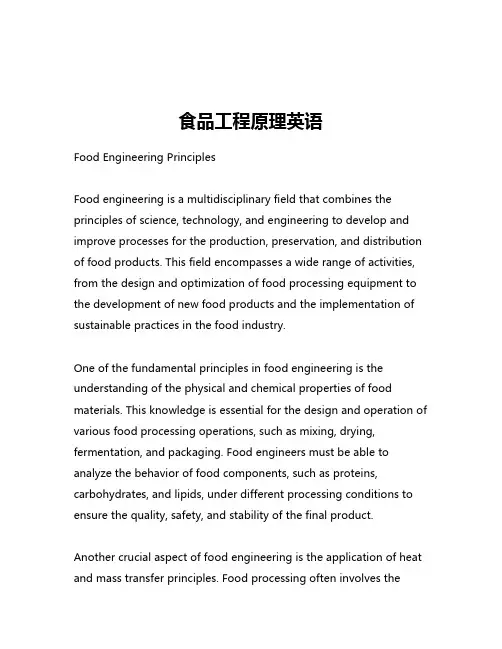
食品工程原理英语Food Engineering PrinciplesFood engineering is a multidisciplinary field that combines the principles of science, technology, and engineering to develop and improve processes for the production, preservation, and distribution of food products. This field encompasses a wide range of activities, from the design and optimization of food processing equipment to the development of new food products and the implementation of sustainable practices in the food industry.One of the fundamental principles in food engineering is the understanding of the physical and chemical properties of food materials. This knowledge is essential for the design and operation of various food processing operations, such as mixing, drying, fermentation, and packaging. Food engineers must be able to analyze the behavior of food components, such as proteins, carbohydrates, and lipids, under different processing conditions to ensure the quality, safety, and stability of the final product.Another crucial aspect of food engineering is the application of heat and mass transfer principles. Food processing often involves thetransfer of heat and mass (e.g., moisture, gases) between the food product and its surroundings, and food engineers must be able to predict and control these processes to achieve the desired product characteristics. This includes the design of heating and cooling systems, the optimization of drying processes, and the understanding of the effects of temperature and pressure on food quality.In addition to the physical and chemical properties of food, food engineers must also consider the microbial aspects of food production and preservation. They must understand the growth and behavior of microorganisms, such as bacteria, yeasts, and molds, and how they can be controlled or eliminated to ensure the safety and shelf-life of food products. This may involve the design of sterilization and pasteurization processes, the development of antimicrobial packaging materials, and the implementation of effective cleaning and sanitation protocols.Another important area of food engineering is the optimization of food processing operations. This involves the use of mathematical modeling and simulation tools to analyze and improve the efficiency, productivity, and sustainability of food processing systems. Food engineers may use techniques such as process control, optimization, and simulation to identify and address bottlenecks, reduce energy and resource consumption, and improve product quality andconsistency.The field of food engineering also encompasses the development of new food products and the improvement of existing ones. Food engineers may work with food scientists and product developers to create innovative food products that meet the changing demands of consumers, such as healthier, more convenient, or more sustainable options. This may involve the use of novel ingredients, the application of new processing technologies, or the optimization of existing formulations and production methods.In recent years, the importance of sustainability and environmental responsibility has become increasingly prominent in the food industry. Food engineers play a crucial role in developing and implementing sustainable practices, such as the use of renewable energy sources, the reduction of waste and emissions, and the optimization of water usage. They may also work on the design of biodegradable packaging materials, the recovery and reuse of food processing byproducts, and the integration of renewable energy sources into food processing facilities.Overall, food engineering is a dynamic and multifaceted field that plays a vital role in the development, production, and distribution of safe, nutritious, and high-quality food products. By applying principles from various scientific and engineering disciplines, foodengineers are constantly working to improve the efficiency, sustainability, and innovation of the food industry, ultimately contributing to the well-being of people and the planet.。
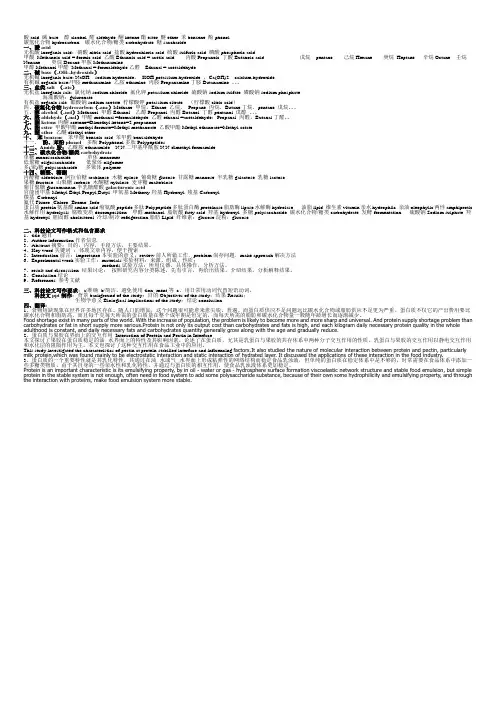
酸acid 碱base 醇alcohol 醛aldehyde 酮ketone酯ester 醚ether 苯benzene 酚phenol碳氢化合物hydrocarbon 碳水化合物/糖类carbohydrate 糖saccharide一、酸acid无机酸inorganic acid:硝酸nitric acid 盐酸hydrochloric acid 硫酸sulfuric acid 磷酸phosphoric acid甲酸Methanoic acid = formic acid 乙酸Ethanoic acid = acetic acid 丙酸Propanoic 丁酸Butanoic acid 戊烷pentane 己烷Hexane 庚烷Heptane 辛烷Octane 壬烷Nonane 癸烷Decane甲胺Methanamine甲醇Methanol甲醛Methanal = formaldehyde乙醛Ethanal = acetaldehyde二、碱base(-OH:-hydroxide)无机碱inorganic base: NaOH sodium hydroxide, KOH potassium hydrox ide ,Ca(OH)2 calcium hydroxide有机碱organic base:甲胺methanamine 乙胺ethamine 丙胺Propanamine丁胺Butanamine 。
三、盐类salt (-ate)无机盐inorganic salt: 氯化钠sodium chloride 氯化钾potassium chloride 硫酸钠sodium sulfate 磷酸钠sodium phosphate海藻酸钠:guluronate有机盐organic salt: 醋酸钠sodium acetate 柠檬酸钾potassium citrate (柠檬酸citric acid)四、碳氢化合物hydrocarbon(-ane)Methane 甲烷,Ethane 乙烷, Propane 丙烷,Butane丁烷,pentane 戊烷。

为什么选择食品科学与工程这个专业英语作文English:I chose to study Food Science and Engineering because I have a strong passion for food and its role in human health and sustainability. This field allows me to combine my interests in biology, chemistry, and engineering to develop and improve food products and processes. Additionally, the current global food challenges, such as food waste and food security, require innovative solutions that can be addressed through this discipline.Moreover, this profession has a wide range of career opportunities, such as food product development, food safety regulation, and quality assurance. Through internships and networking events, I have had the opportunity to work with professionals in these different areas and gain a deeper understanding of the diverse aspects of the food industry.In summary, Food Science and Engineering is a multidisciplinary field that allows me to combine my passions for food, biology andchemistry, and engineering while also providing me with numerous career opportunities. Furthermore, the importance of food in our society and the current challenges of the food industry make thisfield essential for sustainable development.中文翻译:我选择学习食品科学与工程是因为我对食物及其对人类健康和可持续发展的作用有浓厚的兴趣。
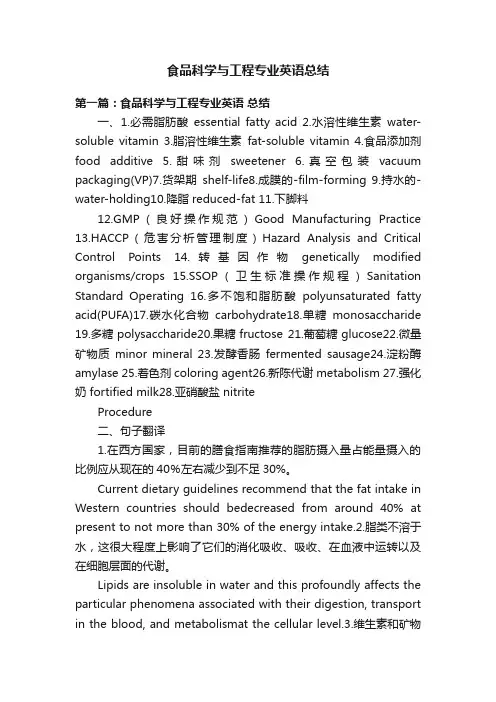
食品科学与工程专业英语总结第一篇:食品科学与工程专业英语总结一、1.必需脂肪酸essential fatty acid 2.水溶性维生素water-soluble vitamin 3.脂溶性维生素fat-soluble vitamin 4.食品添加剂food additive 5.甜味剂sweetener 6.真空包装vacuum packaging(VP)7.货架期shelf-life8.成膜的-film-forming 9.持水的-water-holding10.降脂 reduced-fat 11.下脚料12.GMP(良好操作规范)Good Manufacturing Practice13.HACCP(危害分析管理制度)Hazard Analysis and Critical Control Points 14.转基因作物genetically modified organisms/crops 15.SSOP(卫生标准操作规程)Sanitation Standard Operating 16.多不饱和脂肪酸polyunsaturated fatty acid(PUFA)17.碳水化合物carbohydrate18.单糖monosaccharide 19.多糖polysaccharide20.果糖fructose 21.葡萄糖glucose22.微量矿物质minor mineral 23.发酵香肠fermented sausage24.淀粉酶amylase 25.着色剂 coloring agent26.新陈代谢 metabolism 27.强化奶 fortified milk28.亚硝酸盐 nitriteProcedure二、句子翻译1.在西方国家,目前的膳食指南推荐的脂肪摄入量占能量摄入的比例应从现在的40%左右减少到不足30%。
Current dietary guidelines recommend that the fat intake in Western countries should bedecreased from around 40% at present to not more than 30% of the energy intake.2.脂类不溶于水,这很大程度上影响了它们的消化吸收、吸收、在血液中运转以及在细胞层面的代谢。
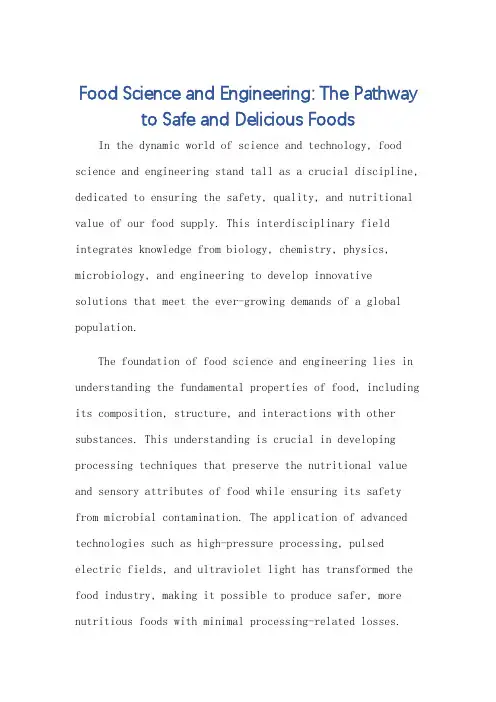
Food Science and Engineering: The Pathway to Safe and Delicious FoodsIn the dynamic world of science and technology, food science and engineering stand tall as a crucial discipline, dedicated to ensuring the safety, quality, and nutritional value of our food supply. This interdisciplinary field integrates knowledge from biology, chemistry, physics, microbiology, and engineering to develop innovative solutions that meet the ever-growing demands of a global population.The foundation of food science and engineering lies in understanding the fundamental properties of food, including its composition, structure, and interactions with other substances. This understanding is crucial in developing processing techniques that preserve the nutritional value and sensory attributes of food while ensuring its safety from microbial contamination. The application of advanced technologies such as high-pressure processing, pulsed electric fields, and ultraviolet light has transformed the food industry, making it possible to produce safer, more nutritious foods with minimal processing-related losses.Moreover, food science and engineering are essential in addressing the global challenge of food security. By developing sustainable production methods, optimizing food distribution systems, and promoting dietary diversity, this field contributes to reducing hunger and malnutrition worldwide. The integration of modern biotechnology, such as genetic engineering and metabolic engineering, offers new possibilities for crop improvement, disease resistance, and increased yields, thus contributing to food sustainability. In addition, the role of food science and engineeringin promoting public health cannot be overstated. Throughthe development of functional foods and beverages enriched with nutrients, probiotics, and antioxidants, this field aims to improve the overall health and well-being of individuals. The study of food-borne illnesses and the identification of food contaminants have led to the development of stringent food safety regulations and guidelines, ensuring that the food we consume is safe and healthy.The future of food science and engineering looks bright, with the emergence of new technologies and research areassuch as nanotechnology, synthetic biology, and personalized nutrition. These advancements will further revolutionize the food industry, leading to the development of more personalized, sustainable, and healthy food products that cater to the diverse needs of consumers worldwide.In conclusion, food science and engineering play a pivotal role in ensuring the safety, quality, andnutritional value of our food supply. By harnessing the power of science and technology, this field has transformed the food industry, making it possible to produce safer, more nutritious foods that meet the needs of a growing global population. As we move forward, the continued innovation and research in food science and engineeringwill be crucial in addressing the challenges of food security, public health, and sustainability.**食品科学与工程:安全与美味食品的途径**在科学和技术日新月异的世界中,食品科学与工程作为一门至关重要的学科,致力于确保我们的食品供应的安全、质量和营养价值。
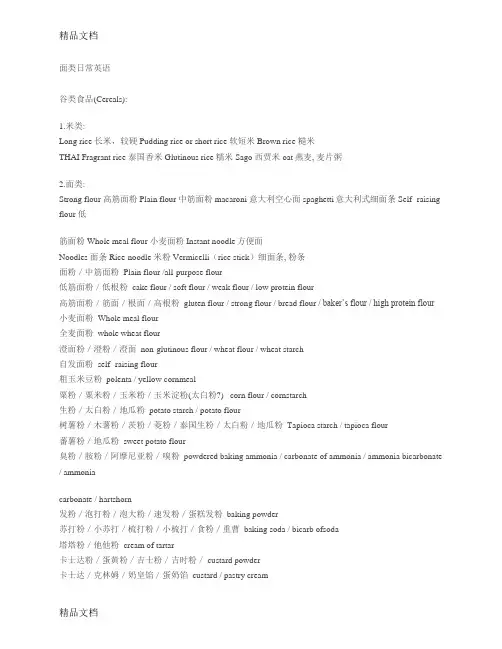
面类日常英语谷类食品(Cereals):1.米类:Long rice 长米,较硬 Pudding rice or short rice 软短米Brown rice 糙米THAI Fragrant rice 泰国香米 Glutinous rice 糯米 Sago 西贾米oat燕麦, 麦片粥2.面类:Strong flour 高筋面粉 Plain flour 中筋面粉 macaroni 意大利空心面spaghetti意大利式细面条Self- raising flour 低筋面粉 Whole meal flour 小麦面粉Instant noodle方便面Noodles 面条 Rice-noodle 米粉Vermicelli(rice stick)细面条, 粉条面粉/中筋面粉 Plain flour /all-purpose flour低筋面粉/低根粉 cake flour / soft flour / weak flour / low protein flour高筋面粉/筋面/根面/高根粉 gluten flour / strong flour / bread flour / baker’s flour / high protein flour小麦面粉 Whole meal flour全麦面粉 whole wheat flour澄面粉/澄粉/澄面 non-glutinous flour / wheat flour / wheat starch自发面粉 self- raising flour粗玉米豆粉 polenta / yellow cornmeal粟粉/粟米粉/玉米粉/玉米淀粉(太白粉?) corn flour / cornstarch生粉/太白粉/地瓜粉 potato starch / potato flour树薯粉/木薯粉/茨粉/菱粉/泰国生粉/太白粉/地瓜粉 Tapioca starch / tapioca flour蕃薯粉/地瓜粉 sweet potato flour臭粉/胺粉/阿摩尼亚粉/嗅粉 powdered baking ammonia / carbonate of ammonia / ammonia bicarbonate / ammoniacarbonate / hartshorn发粉/泡打粉/泡大粉/速发粉/蛋糕发粉 baking powder苏打粉/小苏打/梳打粉/小梳打/食粉/重曹 baking soda / bicarb ofsoda塔塔粉/他他粉 cream of tartar卡士达粉/蛋黄粉/吉士粉/吉时粉/ custard powder卡士达/克林姆/奶皇馅/蛋奶馅 custard / pastry cream蛋白粉 egg white powder粘米粉/黏米粉/在来米粉/在莱米粉/再来米粉 rice flour糕仔粉 cooked rice flour糯米粉 glutinous rice flour / sweet rice flour凤片粉/熟糯米粉/糕粉/加工糕粉 fried sweet rice flour / fried glutinous rice flour 绿豆粉 mung bean flour / tepung hun kwee小麦胚芽/麦芽粉 wheat germ小麦蛋白/面筋粉 wheat gluten酵母/酒饼 yeast/ibu roti面包糠/面包屑 breadcrumbs杂粮预拌粉 multi-grain flour早餐~烧饼 Clay oven rolls油条 Fried bread stick韭菜盒 Fried leek dumplings水饺 Boiled dumplings蒸饺 Steamed dumplings馒头 Steamed buns割包 Steamed sandwich饭团 Rice and vegetable roll蛋饼 Egg s皮蛋 100-year egg咸鸭蛋 Salted duck egg豆浆 Soybean milk米浆 Rice & peanut milk饭类~稀饭 Rice porridge白饭 Plain white rice油饭 Glutinous oil rice糯米饭 Glutinous rice卤肉饭 Braised pork rice蛋炒饭 Fried rice with egg地瓜粥 Sweet potato congee面类~馄饨面 Wonton & noodles刀削面 Sliced noodles麻辣面 Spicy hot noodles麻酱面 Sesame paste noodles鸭肉面 Duck with noodles鹅肉面 Goose with noodles鳝鱼面 Eel noodles乌龙面 Seafood noodles榨菜肉丝面 Pork , pickled mustard green noodles 蚵仔面线 Oyster thin noodles板条 Flat noodles米粉 Rice noodles炒米粉 Fried rice noodles冬粉 Green bean noodle汤类~鱼丸汤 Fish ball soup贡丸汤 Meat ball soup蛋花汤 Egg & vegetable soup蛤蜊汤 Clams soup蚵仔汤 Oyster soup紫菜汤 Seaweed soup酸辣汤 Sweet & sour soup馄饨汤 Wonton soup猪肠汤 Pork intestine soup肉羹汤 Pork thick soup花枝汤 Squid soup花枝羹 Squid thick soup甜点~爱玉 Vegetarian gelatin糖葫芦 Tomatoes on sticks长寿桃 Longevity Peaches芝麻球 Glutinous rice sesame balls麻花 Hemp flowers双胞胎 Horse hooves冰类~绵绵冰 Mein mein ice麦角冰 Oatmeal ice地瓜冰 Sweet potato ice红豆牛奶冰 Red bean with milk ice 八宝冰 Eight treasures ice豆花 Tofu pudding果汁~甘蔗汁 Sugar cane juice酸梅汁 Plum juice杨桃汁 Star fruit juice青草茶 Herb juice点心~蚵仔煎 Oyster omelet棺材板 Coffin臭豆腐 Stinky tofu油豆腐 Oily bean curd麻辣豆腐 Spicy hot bean curd天妇罗 Tenpura虾片 Prawn cracker虾球 Shrimp balls春卷 Spring rolls鸡卷 Chicken rolls碗糕 Salty rice pudding筒仔米糕 Rice tube pudding红豆糕 Red bean绿豆糕 Bean paste猪血糕 Pig''s blood糯米糕 Glutinous rice s萝卜糕 Fried white radish patty芋头糕 Taro肉圆 Taiwanese Meatballs水晶饺 Pyramid dumplings肉丸 Rice-meat dumplings豆干 Dried tofu其它:当归鸭 Angelica duck槟榔 Beatel nut中国小吃英文表达中国吃的文化是由来已久,但怎样把中国吃的文化介绍出去,怎样用英文来表达呢.虽然很多人喜欢以拼音来表达,但没吃过中国小吃的老外肯定是不能理解的。
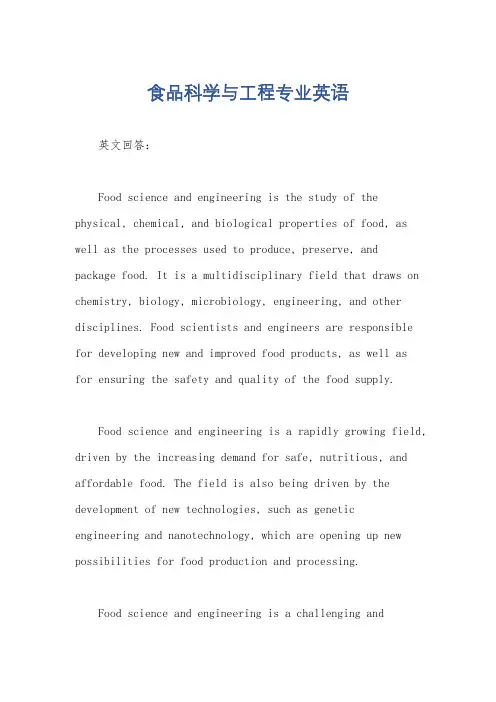
食品科学与工程专业英语英文回答:Food science and engineering is the study of the physical, chemical, and biological properties of food, as well as the processes used to produce, preserve, and package food. It is a multidisciplinary field that draws on chemistry, biology, microbiology, engineering, and other disciplines. Food scientists and engineers are responsible for developing new and improved food products, as well asfor ensuring the safety and quality of the food supply.Food science and engineering is a rapidly growing field, driven by the increasing demand for safe, nutritious, and affordable food. The field is also being driven by the development of new technologies, such as geneticengineering and nanotechnology, which are opening up new possibilities for food production and processing.Food science and engineering is a challenging andrewarding field. Food scientists and engineers have the opportunity to make a real difference in the world by helping to solve the global food crisis and by ensuring the safety and quality of the food supply.中文回答:食品科学与工程是一门研究食品的物理、化学和生物特性,以及食品的生产、保存和包装过程的学科。
L4WHO has been actively participating in the development of principles and recommendation for the safety assessment of GM foods derived from genetically modified organisms (GMO).世界卫生组织现已积极的参与到评价对转基因食品安全的原则和建议中。
世界卫生组织现已积极的参与到对转基因食品的安全评估的原则和建议的发展中。
The result developed in the course of various expert consultations from the basis for guidelines on national levels and are presently being incorporated into internationally recognized standards.不同专家基于本国的技术水平而商讨的结果目前已被作为公认的权威标准。
这个结果在各种专家磋商会议中得以发展并形成了国家水平指导方针的基础,目前正编入国际公认的标准中。
The next generation of genetically modified foods will be crops with improved nutritional value, thus crossing the borderline to “functional foods” and “nutraceuticals”.我方准备把高蛋白玉米作为下一代的转基因食品,并将打破功能食品与螺旋杆菌间定义上的灰色界限下一代转基因食品将是营养价值得到提高的作物,因此它跨越了功能食品和营养食品的界限。
Evaluations will increasingly have to consider the impact of a GM food on the overall nutritional status taking into account the different needs in developed and developing countries .评估机构必将倾向于考虑转基因食品对人体蛋白比率的影响以确保其符合发展中与发达国家的不同需求考虑到发展国家和发展中国家的不同需求,评估将越加考虑转基因食品在总营养状况方面的影响。
多用单词:Emulsifying乳化的 Biotin生物素 Choline胆碱 Phytochemicals 植物素 caramelization焦糖化反应 Preventing spoilage防止变质Monosaccharides单糖 Oligosaccharide 低聚糖Polysaccharides 多糖pyrolysis热解fudge软糖gelatinization凝胶化irreversible swelling不可逆溶胀hemi-cellulose半纤维素Xylan木聚糖,arabinogalactan, 阿拉伯半乳聚糖galactoglucomannan半乳葡甘露聚糖 pectin果胶agar琼脂 algin 藻胶 xanthan gum黄原胶 Glycogen糖原 trypsin 胰蛋白酶 pepsin 胃蛋白酶 ovalbumin卵清蛋白 ferritin铁蛋白hemoglobin血红蛋白 lipoproteins脂蛋白 actin and myosin肌动蛋白和肌球蛋白thrombin凝血酶 insulin胰岛素 collagen胶原keratin角蛋白elastin粘性蛋白Membranes细胞膜Thiamin硫胺素vb1 Riboflavin核黄素vb2 alpha tocopherol生育酚 Niacin烟酸Pantothenic acid泛酸 Folic acid.叶酸 coenzyme辅酶 osmosis 渗透作用 amylose直链淀粉 amylopectin支链 rancidity酸败bran麸皮 pyramid金字塔 glycerol甘油 preservatives防腐剂constipation便秘diverticular憩室的hemorrhoids痔疮Diabetes糖尿病Osteoporosis骨质疏松症Cardiovascular diseases心血管疾病 anthocyanidin花青素 polyphenol多元酚pigments色素 spectrophotometers分光光度计 astringency涩味Nitrogen氮purines嘌呤, pyrimidines嘧啶porphyrin卟啉adenosine triphosphate三磷酸腺苷linoleic acid亚油酸Thyroid function甲状腺功能citric柠檬酸 isocitric异柠檬酸 malic苹果酸 Oxalic草酸, tartaric酒石酸, succinic acids.琥珀酸esters酯类 alcohols醇类 ethers醚类, ketones.酮类 Heat denaturation热变性sterilization灭菌 sanitizing消毒membrane processing膜处理microfiltration微过滤sediment沉淀物ultrafiltration超滤 carotene胡萝卜素 hydrophobic疏水性hydrophilic亲水性 hydrogel水凝胶chiral手性的D-glycerose D-甘油醛 heteroglycan杂聚糖polyunsaturated 多不饱和键的catalyst 催化剂翻译句型:Although metals are crystalline solids, this is not immediately apparent when they are examined under a microscope.虽然金属是晶体,但是当在显微镜下观察时,并不是立刻就那么明显。
我的专业食品科学与工程英语作文范文My Major in Food Science and EngineeringIntroductionFood Science and Engineering is a field that combines the science of food with the engineering principles to develop and produce safe, nutritious, and delicious food products. As a student majoring in Food Science and Engineering, I have the opportunity to study a wide range of subjects including food chemistry, food microbiology, food processing, and food safety. In this essay, I will discuss why I chose this major, my experiences studying it, and my future career goals in the field.Why I Chose Food Science and EngineeringI chose to major in Food Science and Engineering for several reasons. First and foremost, I have always had a passion for food and cooking. I am fascinated by the science behind food and the way different ingredients interact with each other to create delicious dishes. By studying Food Science and Engineering, I am able to gain a deeper understanding of the food production process and learn how to create innovative food products that are not only tasty but also safe and nutritious.Additionally, I believe that the food industry plays a crucial role in society as it provides sustenance to people all over the world. As a Food Science and Engineering student, I am learning how to ensure that the food we consume is of high quality and free from contaminants. This knowledge is important in safeguarding public health and promoting food security.My Experiences Studying Food Science and EngineeringStudying Food Science and Engineering has been a rewarding experience for me. I have had the opportunity to learn from knowledgeable professors who are experts in their field. The practical labs and hands-on projects have allowed me to apply the theoretical knowledge I have gained in the classroom to real-life situations. For example, in my food chemistry lab, I learned how to analyze the chemical composition of different food products using techniques such as chromatography and spectroscopy. These hands-on experiences have deepened my understanding of food science and enhanced myproblem-solving skills.One of the highlights of my studies was a research project I conducted on the effects of food processing techniques on the nutritional content of fruits and vegetables. I spent several months conducting experiments and analyzing data to evaluatehow different processing methods such as freezing, drying, and canning affect the vitamin and mineral content of fruits and vegetables. This project allowed me to apply my knowledge of food chemistry and nutrition to a real-world problem and develop valuable research skills.Future Career GoalsAfter graduation, I plan to pursue a career in the food industry where I can apply my knowledge of Food Science and Engineering to develop new food products and improve existing ones. I am particularly interested in working in product development, where I can use my creativity to create innovative and healthy food products that meet consumer demands. I also aspire to work in food safety and quality assurance, where I can help ensure that the food we consume is safe and meets regulatory standards.In conclusion, majoring in Food Science and Engineering has been a fulfilling and enriching experience for me. I am grateful for the opportunities I have had to learn from knowledgeable professors, conduct research, and gain hands-on experience in the field. I am excited about the future and look forward to applying my skills and knowledge to make a positive impact in the food industry.。
29. What are the final products of wheat wet milling? What about their uses?-main products: starch, 66%; 湿磨终产物-by products: oil, 4%; animal feed, 30%, including 24%, gluten feed (PC, 21%) and 5.7% gluten meal (PC, 60%).Uses: -modified starch;-sweeter;-alcohol;-others30. What are the uses of vital gluten? 活力粉用途-improving the texture and raising the protein content;-forming an extensible, elastic mass;-fortification of week hour;-high protein break making;-high fiber bread making;-others, meat products, e.g. sausages, breakfast food.1.What’s defination of oils and fats? 油脂分类Edible fats and oils are esters of the three carbon trihydric alcohol, glycerin, and various straight chained monocarboxylic acids known as fatty acids.2.what’s the major and minor component of edible oils and fats?Triglyceride; 食用油和油脂主次成分Diglyceride monoglyceride phospholipids sterol cholesterol tocopherol pigments 3 What are the major fatty acids of oils and fats? 油脂主要脂肪酸Palmitic oils stearic oils oleic linoleic linolenic4.Classification of oils and fats 油脂分类Saturated monounsaturated polyunsaturated5.Iodine vaule 碘值he number of centigrams iodine absorbed by 1g of fat or percentage iodine absorbed.6. Saponification value : 皂化值the weight in milligrams of potassium hydroxide needed to completely saponify 1 g of fat.7. Peroxide Value 过氧化值the milliequivalents of iodine formed per kilogram of fat.8.Acid Value 酸价The milligrams of potassium hydroxide needed to neutralize the free fatty acids in 1g of a fat9.Meat fat: 动物油Butterfat 、Lard 、TallowVegetable fat 植物油Canola Coconut Corn Cottonseed Olive Palm and Palm Kernel Peanut Safflower Soybean Sunflow er10. The general guideline for oilseed storage is low moisture, low temperature and aeration.11. Oil Extraction:油萃取Seed Preparation Rendering Pressing Solvent Extraction12. Degumming:脱胶Degumming is carried out by adding 2% water to the oil.Remove phosphslipids13 Refining 精炼Refining usually refers to the removal of nonglyceride fatty materials by washing the oils with strongly alkaline water solutionsRemove Free fatty acids.14. Bleaching 漂白Bleaching is the process used for the removal of pigments from the oilRemove pigments15.Deodorization 除臭Deodorization is the process whereby the odors and flavors of fats and oils are removed,Remove volatilized gas16. Fractional Crystallization 分离结晶Winterization冬化Dewaxing脱蜡Stearine Separation硬脂酸分离17. Hydrogenation:Hydrogenation is the treatment of fats and oils with hydrogen gas in the presence of a catalyst. 加氢18. Interesterification:interesterification is the exchange of acyls of triglycerides of two separate fats or a single fat. 酯化作用19.What are the main protein products? 蛋白质产品Protein flour; protein concentrates ;protein isolates;texturized protein20.What is defatted soybean protein flour? 脱脂大豆蛋白粉Flour produced by the nearly complete removal of the oil fromsoybeans by the use of hexane or other homologous hydrocarbon solvents.21.How is edible soybean soybean protein flour produced? 可食大豆蛋白粉Soybean storage→soybean cleaning→soybean tempering→dehulling→conditioning and flaking→extraction and desolventizing→toasting→flour and grit grinding→fat-conditioning soybean protein flour22、What’s the definition of soybean protein concentrates? 大豆集中蛋白soybean protein concentrate is a product having a protein content of 70% (N×6.25) on a moisturefree basis.23.How to produce soybean protein concentrates? 大豆浓缩蛋白(1)Extraction with aqueous acids in the isoelectric range of pH 4-5.(2)Extraction with aqueous alcohol.(3)defatted flakes or flour are moist heat treated to denature and thereby insolubilize the protein.24.How to immobilize the major protein fraction in soybean? 固定大豆蛋白a. Leaching with Aqueous Organic Solvents.b. Leaching with Dilute Acid.25.What are soybean protein isolates? 大豆分离蛋白isolated soy proteins must contain not less than 90% dry-basis protein (Nitrogen×6.25).26.How many functional properties do vegetable have?What are they?蔬菜功能特性(1)Hydration and Water Absorption (2)Solubility (3)Viscosity and Gelation (4)Texturization (5)Emulsion and Foaming (6)Color, Flavor, and Odor27、How many methods can be used to produced texturized protein? What are they?脉络产生蛋白质Three. Extrusion ;spinning ; steam texturizing28.Process for Producing Soybean Protein Isolates 大豆分离蛋白生产工艺The starting material for soy protein isolate is finely ground, defatted flakes that have been desolventized by a vacuum process for maintaining protein solubility. The protein is extracted with dilute alkali, pH 9, at 50-55℃. Stronger alkali would extract more protein but would also cause more damage particularly to the sulfur-containing amino acids. The solids are separated by screening and centrifuging and contain primarily insoluble carbohydrates and proteins. The soluble protein portion is adjusted to pH 4.5 with food grade acid. This results in a protein precipitate and a whey fraction). The precpitate is washed,neutralized ,sterilized and then dried to yield a soy proteinate.29.What is the difference between the bulk density and absolute density ?bulk density 相对密度和绝对密度区别Definition: The weight of a given volume of grain including the voids is the bulk density of the material.Bulk density is a widely used grain property.It is part of the U.S. grain standards.absolute densityDefinition: The absolute density of the grain is the weight per unit volume of the grain itself, independent of the voids between the grain.The density of the grain can be determined by an air comparison pycnometer30.What is the angle of repose ? 静止角Definition: When poured on a level surface, grain forms a pile whose outer edge makes an angle to that surface. The value of the angle is specific to the grain and is called the angle of repose.31. What is the impact factors of angle of repose ? 静止角影响因素Impact factors:♦Including frictional forces generated by grain flowing against itself, the distribution of weight throughout the grain mass, and the moisture content of the grain.♦The angle of repose determines whether the grain will flow of its own accord or whether outside force is necessary to move it.32. What is the hardness of grain ? 粮食硬度An important attribute of grains is their hardness, their resistance to being broken or reduced in particle size.(Large variation often even occurs within a single species (wheat, for example) of grain.The variation can be caused by both genetic differences and differences in thegrowing environment.)33.What is the practical significance of moisture in grain? 现实意义粮食水分Practical significance:determine the grain’s corresponding grade, price and quality;and further affect the grain’s safe storage.34. Please introduce the important methods to measure the moisture content of grains and their products. 衡量粮食水分的方法Many methods have been developed to measure moisture content of grains and their products. The best known are :1) oven drying;2) vacuum oven drying, with and without a desiccant;3) distillation;4) chemical reaction with the Karl Fischer reagent;5) electronic devices or moisture meters;6) nuclear magnetic resonance (NMR);7) near- infrared ( NIR) spectrophotometry.35. What is the pesticide?农药Pesticide: Anything that inhibits or kills a pest such as weeds, fungi, insects, and rodents.36. What is chemical grain protectant ? 杀虫剂Grain protectants are materials that will persist for extended periods at concentrations lethal to the target insects.37. What is fumigant ? 熏蒸剂A fumigant is a chemical that exists as a gas at ambient temperatures andpressures or produces a gas from a solid or a liquid.38. What characteristics are an ideal fumigant should possess ? 熏蒸剂特征An ideal fumigant should1) have low cost per effective fumigation;2) be highly and acutely toxic to all stages of the target pest, but not unduly hazardous to man and other higher animals;3 ) be highly volatile, with a good ability to penetrate, but not be excessively absorbed by the commodity;4) have adequate warning properties for easy detection;5) be noncorrosive, nonflammable, and nonexplosive under practical conditions;6) possess a good storage life;7) be nonreactive with the commodity, so as not to produce adverse odors and flavors;8) be readily removable by aeration, leaving no harmful residues;9) be noninjurious to seed germination;10) be nondamaging to miling qualities or other processing properties of grain;11) be readily available and simple to apply.39. What must you pay attention to when you use the fumigants to effectively control the stored-grain insects? 使用熏蒸剂控制昆虫Primary factors that decrease or increase the distribution of fumigants into grain and their biological activity are temperature, moisture, time, fumigant formulation, dosage, application procedure, storage structure, aeration, dockage, insect population characteristics, and grain kernels.40:What is the meaning of food processing ?食品加工的意义?答:Increase the value of agriculture products and by-products;增加农业产品的价值和副产品;Prolong the storage period;延长贮藏期;Improve the safety of food;改善食品的安全问题;More nutritive、diversified and convenient.更多的营养、多样化和方便41:The classification of food material . Point out some common food materials.食品材料的分类。
介绍食品科学与工程专业的英语作文English:Food Science and Engineering is a multidisciplinary field that encompasses the study of food composition, processing, preservation, and safety to ensure the production of safe, nutritious, and high-quality food products. Students in this field learn about the chemical, physical, and biological properties of food components, as well as the principles behind food processing techniques such as heating, cooling, drying, and fermentation. They also study food microbiology to understand the behavior of microorganisms in food and develop strategies to prevent foodborne illnesses. Additionally, students gain knowledge in food engineering, which involves the design and optimization of food processes and equipment to improve efficiency and quality. With a focus on sustainability and innovation, food science and engineering professionals work to develop new food products, enhance food safety measures, and improve food production methods to meet the demands of a growing global population while minimizing environmental impact.Translated content:食品科学与工程是一个跨学科领域,涵盖了食品成分、加工、保藏和安全的研究,以确保生产安全、营养丰富和高质量的食品产品。
介绍食品科学与工程专业的英语作文【中英文版】Title: An Introduction to Food Science and EngineeringFood Science and Engineering is a multidisciplinary field that combines the study of food chemistry, microbiology, processing technology, and engineering principles to enhance the safety, quality, and sustainability of food production and processing.This specialized field plays a crucial role in ensuring food security, addressing food-related challenges, and meeting the growing demand for safe and nutritious food globally.The study of food chemistry in Food Science and Engineering focuses on understanding the chemical composition of food, the physical properties of food components, and the changes that occur during food processing and storage.This knowledge is essential for developing food preservation techniques, improving food quality, and ensuring food safety.Food microbiology is another critical aspect of this field.It involves studying the microorganisms that naturally occur in food and the role they play in food spoilage, fermentation, and foodborne illnesses.Understanding these microorganisms helps in implementing effective food preservation strategies and ensuring the safety of food products.Food processing technology is the core of Food Science and Engineering.It encompasses the methods and techniques used to transform raw agricultural products into safe, palatable, and marketable food products.This includes processes such as harvesting, handling, cleaning, sorting, grading, packaging, preservation, and processing.Students in this field learn about various food processing equipment and technologies, food plant design, and quality control systems.In addition to these core subjects, Food Science and Engineering also covers topics such as food engineering principles, food safety and quality management systems, food laws and regulations, and the impact of food production and consumption on the environment.This comprehensive approach ensures that professionals in this field have the knowledge and skills to address the complex challenges facing the food industry.The demand for food scientists and engineers is increasing globally.They are employed in various sectors such as food and beverage manufacturing, foodservice, research and development, regulatory agencies, and academia.The role of these professionals goes beyond ensuring food safety and quality; they also contribute to developing sustainable food production systems, reducing food waste, and promoting nutrition and health.In conclusion, Food Science and Engineering is a vital field thatencompasses the study of food chemistry, microbiology, processing technology, and engineering principles.Professionals in this field play a significant role in ensuring food safety, quality, and sustainability.With the growing global population and the increasing demand for safe and nutritious food, the importance of Food Science and Engineering is likely to grow in the coming years.。
一、1.必需脂肪酸 essential fatty acid2.水溶性维生素 water-soluble vitamin3.脂溶性维生素 fat-soluble vitamin4.食品添加剂 food additive5.甜味剂 sweetener6.真空包装 vacuum packaging (VP)7.货架期 shelf-life 8.成膜的- film-forming9.持水的- water-holding 10.降脂 reduced-fat11.下脚料12.GMP(良好操作规范) Good Manufacturing Practice13.HACCP(危害分析管理制度)Hazard Analysis and Critical Control Points14.转基因作物 genetically modified organisms/crops15.SSOP(卫生标准操作规程)Sanitation Standard Operating Procedure16.多不饱和脂肪酸 polyunsaturated fatty acid (PUFA)17.碳水化合物 carbohydrate 18.单糖 monosaccharide19.多糖 polysaccharide 20.果糖 fructose21.葡萄糖 glucose 22.微量矿物质 minor mineral 23.发酵香肠 fermented sausage 24.淀粉酶 amylase25.着色剂 coloring agent 26.新陈代谢 metabolism27.强化奶 fortified milk 28.亚硝酸盐 nitrite二、句子翻译1.在西方国家,目前的膳食指南推荐的脂肪摄入量占能量摄入的比例应从现在的40%左右减少到不足30%。
Current dietary guidelines recommend that the fat intake in Western countries should be decreased from around 40% at present to not more than 30% of the energy intake.2.脂类不溶于水,这很大程度上影响了它们的消化吸收、吸收、在血液中运转以及在细胞层面的代谢。
Lipids are insoluble in water and this profoundly affects the particular phenomena associated with their digestion, transport in the blood, and metabolism at the cellular level.3.维生素和矿物质通常被称为微量元素,因为身体对他们的需求量很小。
但是如果未能摄取这微量的成分,肯定会导致疾病。
Vitamins and minerals are often called micronutrients because your body needs only tiny amounts of them. Yet failing to get even those small quantities virtually guarantees disease.4.食品添加剂可以定义为:为改善食品品质和色、香、味,满足加工需要,延长保质期等目的,在食品生产、加工、贮藏或者包装过程中所用到的一类物质。
Additives may be defined as a class of substances that are used in food production, processing, storage and packaging to extend shelf-life of purpose and to meet the processing needs for improving quality, color, flavor and taste.5.用盐和/或糖加调味料、草药以及其他植物性原料腌制斩碎的肉和脂肪,将这些腌制过的混合物灌装到肠衣中形成干制的香肠,这种生产方式可以追溯到公元前好几个世纪。
The chopping or mincing of meat and fat with curing salt and/or sugar together with spices, herbs, and other plant material, followed by the stuffing of such mixture to form a ‘sausage’ that is left to dry is a practice dating back to centuries before the Common Era.6.但是,对于食品工业,主要目标是获得一种在应用中具有较高活性并且价格经济的酶。
However, for the food industry, the prime goal is to obtain an enzyme which offers a high performance for the applications in question at an economic price.7.食品加工业种类多样,既涉及到一些只需要最少化加工的产品,如新鲜果蔬,又涉及到那些需要大量二次加工的制成品,如干麦片或焙烤食品。
The industry is relatively diverse, dealing with some products that need minimal processing, such as fresh fruits and vegetables, and others that require substantial secondary processing to create a final product, such as dry cereal or goods.8.本文主要的目的是研究冷冻保藏时间对于速冻水饺的理化性质、微生物指标及感官特性的影响。
The paper aims to investigate the effect of storage period on the chemical, microbiological and sensory characteristics of frozen dumpling.9.用三个浓度(40%,50%,和60%的固体基质)的麦芽糊精和BμCHI B-190型喷雾干燥机来干燥含有20%总可溶性固形物的浓缩酸橙汁。
Concentrated lime juice with 20% total soluble solid was dried was dried using three levels of maltodextrin (40%,50%,and 60% solid base) and a BμCHI B-190 spray dryer.10.喂食转基因大豆的兔子肝脏酶产量发生变化,与此同时,代谢活动也升高了。
Rabbits fed GM soy showed altered enzyme production in their lives as well as higher metabolic activity11.应该指派一个合适的人/多人(最好是经理)负责工厂的食品安全计划。
There should be an appropriate person (preferably manager)assigned responsibility for the facility food safety program.12.食品从业者应该确保有恰当的产品、特定的知识和专业技术从而建立和实施一个有效的HACCP计划。
HACCP计划最好是由一个多学科的小组来完成。
The food operation shall assure that the appropriate product specific knowledge and expertise is available for the development of an effective HACCP plan this may best be accomplished by assembling a multi-disciplinary team.13. Fig.5 Amount of acrylamide in the crust图5 面包皮中丙烯酰胺形成的量14. Fig.1 Schematic representation of the manufacturing procedure for synbiotic ice cream in this study图1 本研究中益生菌冰激凌制造工序图示15.Fig.7 Relationship between crust color, acrylamide formation, crust temperature and water content图7 面包皮颜色、丙烯酰胺形成、面包皮温度与含水量之间的关系16.Table 2 Effect of soaking, cooking and dehulling on protein, starch and ash stored under various conditions表2 浸泡、烹饪和脱壳对豌豆蛋白、淀粉及灰分含量的影响17.Table 1 Analysis of variance of variety and treatment(soaking, cooking and dehulling) on composition of field peas表1 品种与处理(浸泡、烹饪和脱壳)对紫化豌豆构成的方差分析。